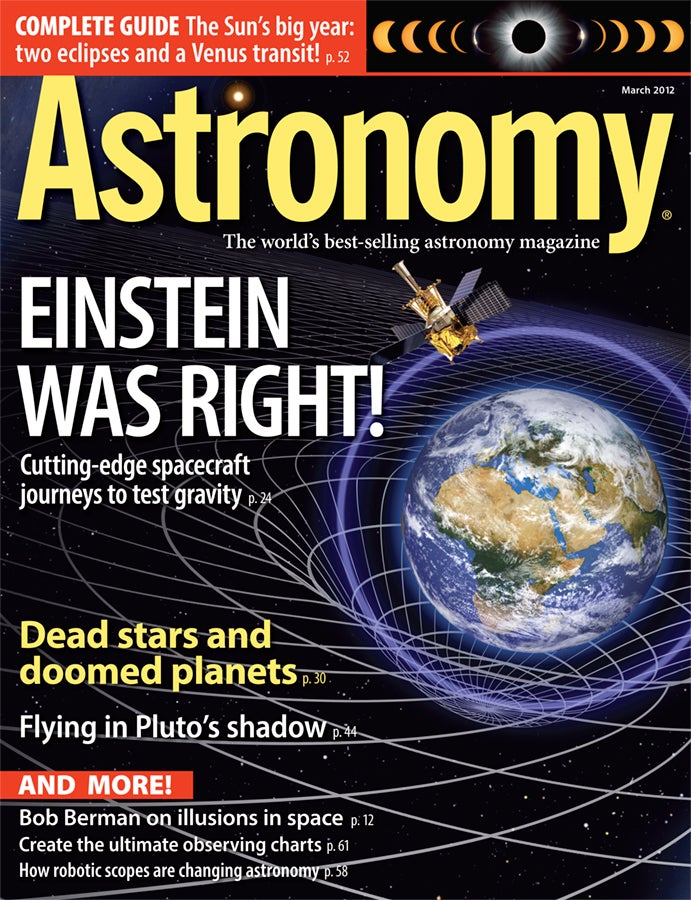
WAUKESHA, Wis. — For nearly 100 years, Albert Einstein’s conceptions of the universe have reigned supreme. His general theory of relativity may be confusing to some, but it’s the best way science has of explaining how gravity works. When scientists set out to confirm some of gravity’s weirder effects in the mid-20th century, they began an adventure that invented new technologies, provided new insights, and lasted almost 50 years.In “Probing Einstein’s relativity,” Associate Editor Liz Kruesi tells the grueling tale of Gravity Probe B (GP-B). “The project’s concept was straightforward,” she writes. “In practice, it was much more difficult.” Throughout numerous hardships such as management challenges and launch delays, the GP-B team eventually launched its mission in 2004, oftentimes inventing the necessary tools to do so.Complementing the overwrought GP-B history, Kruesi gives readers an overview of Einstein’s theory, explaining the subtle effects of relativity that the probe looked for and studied. Despite creating some of the most perfect experimental equipment ever, the GP-B team had challenges to overcome even after the probe’s 50 weeks of observing time in space. “It took years of detective work,” Kruesi writes, “but scientists unraveled the data.” Not only was Einstein indeed right, but the team had also developed new technologies and a better understanding of how space-time works.Pick up the March issue of Astronomy, on newsstands January 31, to learn more about Gravity Probe B’s successes and failures.
“Dead stars and doomed planets”
In “Dead stars and doomed planets,” scientists John H. Debes and Marc J. Kuchner tell “a ghost story that starts in the future,” detailing the grisly demise of our Sun and its planets. After going through a red giant phase and becoming a white dwarf, such stars like ours have an eerie dusty disk encircling them. “This story has occurred over and over to stars and planetary systems throughout the cosmos,” the authors write. Thanks to the space telescopes of the early 21st century, astronomers have discovered some 20 such systems, and learned how they work, which allows them to better understand the evolution of planetary systems, as well as the eventual fate of our Sun and solar system.
“2012 — a historic year for solar eclipses”
The Sun puts on a variety of interesting and unusual shows this year, and Senior Editor Richard Talcott explains every detail. Whether it’s May’s annular eclipse, June’s transit of Venus (the last until the year 2117), or November’s total eclipse, turn to “2012 — a historic year for solar eclipses” to know what, when, and where to watch.
“Create the ultimate observing charts for free”
In “Create the ultimate observing charts for free,” frequent contributor Alan Goldstein describes two websites that amateur and professional astronomers count on for useful information, which you can use to plan your observing sessions. The NASA Extragalactic Database and the Set of Identifications, Measurements, and Bibliography for Astronomical Data provide visitors with magnitudes, locations, and even images of astronomical objects, all for no charge.
Also in the March 2012 Astronomy
- “Flying in Pluto’s shadow” — NASA’s new airborne observatory can travel nearly anywhere, including to the elusive center of a distant planet’s shadow on Earth.
- “How robotic telescopes are changing astronomy” — Automated observatories run telescopes themselves, allowing astronomers to focus on the results.
- “The Sky this Month” — Exclusive pullout star charts will guide you through March’s night sky.
- The March issue of Astronomy also includes Astro News, Bob Berman’s Strange Universe, Glenn Chaple’s Observing Basics, Stephen James O’Meara’s Secret Sky, Tony Hallas’ Imaging the Cosmos, Ask Astro, Beautiful Universe, Deep-sky Showcase, New Products, Reader Gallery, and The Cosmic Grid.









